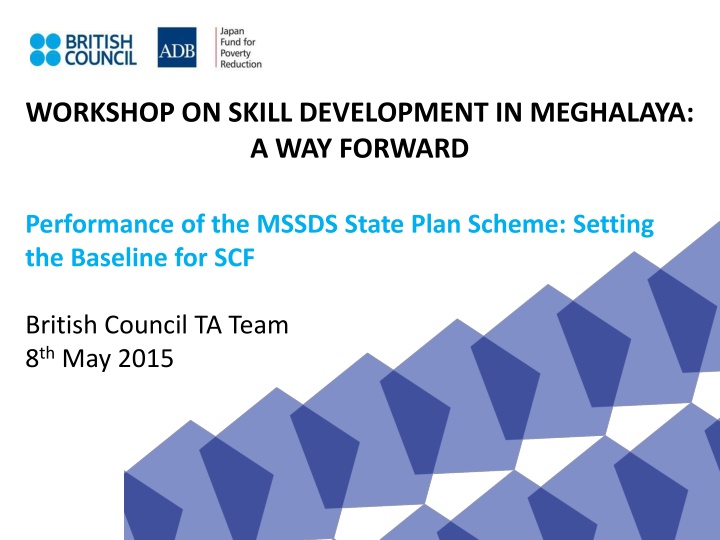Performance Assessment of MSSDS Skills Training Programme in Meghalaya
The workshop on skill development in Meghalaya focused on assessing the performance of the MSSDS state plan scheme, providing demand-driven placement-linked skills training to unemployed youth. The scheme targets youth aged 18-35, with a goal of achieving employment for at least 75% of trained individuals. The presentation outlined objectives, data sources, trainee profiles, training types, efficiency indicators, labor market outcomes, and recommendations for improvement.
Download Presentation

Please find below an Image/Link to download the presentation.
The content on the website is provided AS IS for your information and personal use only. It may not be sold, licensed, or shared on other websites without obtaining consent from the author.If you encounter any issues during the download, it is possible that the publisher has removed the file from their server.
You are allowed to download the files provided on this website for personal or commercial use, subject to the condition that they are used lawfully. All files are the property of their respective owners.
The content on the website is provided AS IS for your information and personal use only. It may not be sold, licensed, or shared on other websites without obtaining consent from the author.
E N D
Presentation Transcript
WORKSHOP ON SKILL DEVELOPMENT IN MEGHALAYA: A WAY FORWARD Performance of the MSSDS State Plan Scheme: Setting the Baseline for SCF British Council TA Team 8th May 2015
Performance Assessment of MSSDS Skills Training Programme Outline of the Presentation About MSSDS state plan scheme Objectives of performance assessment Data Source/Methods Profile of trainees Types of skills training imparted & their features Performance of internal efficiency indicators Labour market outcomes of training interventions Key Concerns/Recommendations
Performance Assessment of MSSDS Skills Training Programme About the Programme MSSDS state plan scheme for skills development launched during January 2014; Overall objective of the scheme is to provide demand driven placement linked skills training to unemployed youths in the age-group of 18-35 years; The scheme is inclusive in nature & caters to all segments of Meghalaya s youth with maximum focus to provides benefits to women & SC/ST youth ; Aims to provide employment to at least 75% of trained youth - in organized sector within and outside Meghalaya; The training cost per trainee is fixed at Rs. 18, 800/- & is shared between the MSSDs & PIAs in the ratio of 75: 25 (Rs.14, 100/- : Rs. 4,700/-); About 7550 youth have been targeted to be trained within two years (between March 2014 - March 2016)
Performance Assessment of MSSDS Skills Training Programme Objectives Understand the performance outcome of the MSSDS state- plan scheme; Linking the MSSDS performance outcome results in setting baseline KPIs for the SCF; Provides suggestions and recommendations for improving the outcome of the MSSDS scheme; Drawing lessons from the MSSDS scheme and its relevance for SCF implementation.
Performance Assessment of MSSDS Skills Training Programme Data Source/Methods Comprehensive and process driven data capture format was prepared to collect data on various monitoring parameters; PIAs were involved in the process and their views were incorporated in the data capture format; Data collection and validation went through a series of rigorous quality check and standardisation processes; About 3327 trainee data trained during 1st April 2014 31st March 2015 were analysed for performance assessment.
Performance Assessment of MSSDS Skills Training Programme Who are the trainees? Trainees are mostly young : average age being 22 years. No significant difference in age between male and female trainees; Age Group of MSSDS Trainees .2 .15 Density .1 .05 0 15 20 25 30 35 40 Age Trainees
Performance Assessment of MSSDS Skills Training Programme Who are the trainees? 34 % of trainees are females (proportion of female trainees are in the range of 43-47 % in Ri-Bhoi & East Khasi Hills respectively); 93 % of male and female trainees belong to ST category; 84% are Christians & 14% Hindus; Around 0.3 % of trainees belong to PWD category; 29% trainees were from border areas.
Performance Assessment of MSSDS Skills Training Programme Who are the trainees? Educational attainment level of trainees is fairly high: 52 % & 25% - secondary & higher secondary & above level of education respectively; Only 23% have less than 9 years of education. EDUCATIONAL LEVEL OF MALE & FEMALE TRAINEES 55.6 51.5 43.5 36.1 25.0 24.8 23.1 19.8 19.3 MALE FEMALE TOTAL Below Secondary Secondary Higher Secondary and Above
Performance Assessment of MSSDS Skills Training Programme Where are the trainees from? Majority of trainees belong to East (30%) and West Khasi (15%) Hills and least from South West Khasi (0.3%) and Jaintia (0.4%) Hills; Distribution of Trainees by Districts (in %) East Garo Hills 2.8 5.7 7.8 East Jaintia Hills 14.7 East Khasi Hills Jaintia Hills North Garo Hills 30.1 11.9 Ri-Bhoi South Garo Hills 0.3 9.0 South West Garo Hills 7.2 6.8 0.4 South West Khasi Hill 3.1
Performance Assessment of MSSDS Skills Training Programme What are the types of skills training imparted ? Training is imparted in 15 different types of trades as per the local market demand with 3,227 enrolled trainees Sl No. PIAs Trades of Skills Training Total Enrollment Computer Fundamentals, Hospitality & Retail 1 Centum Learning 122 2 Automobile Repair, Basic Welding, Construction, Electrical, Hospitality - General, Industrial Sewing Machine, & Security DB Tech 1,222 3 Basic Electrician, Helper Mason, Hospitality, Retail & Sewing Machine Operator IL&FS 1,099 4 NESA General Security 210 5 NIPS Hospitality 242 6 SS Netcom ITES 332 Total 3,227
Performance Assessment of MSSDS Skills Training Programme What are the types of skills training imparted? Hospitality, electrical & security are most popular one among male trainees, whereas for females ISMO, hospitality and ITES are the popular ones Popular Trades among Male & Female Trainees (%) 50.0 43.2 40.0 35.1 32.8 30.0 24.6 20.0 16.1 14.6 7.6 7.3 10.0 5.2 2.6 2.3 1.7 1.6 1.4 1.3 1.0 1.0 0.3 0.1 0.1 0.1 0.0 0.0 Male Female Electrician/Electrical Computer Fundamentals Helper Mason Industrial/ Sewing Machine Operator Automobile Repair Construction Hospitality Retail Basic Welding Security ITES
Performance Assessment of MSSDS Skills Training Programme What are the types of skills training imparted? DB Tech & ILFS are important PIAs account for 38% & 34% of total enrolled trainees respectively; Training is imparted for a duration of 1 to 3 months (except for hospitality course of NIPS which is for 5 months); Assessment & certifications are done internally except for NIPS 5 month hospitality course which is affiliated with the SCVT;
Performance Assessment of MSSDS Skills Training Programme Dropout rates are insignificant Dropout rate at 9.3 % is very low at the overall level no significant differences in dropout rates among male (9.6%) & female (8.6%) trainees; However, dropout rates are high in individual trades such as - Computer fundamentals (48%), helper mason (19%) and sewing machine operator trades (15%); In terms of share in total dropouts hospitality (41%) and basic electrician (12%) together account for 53% of dropped out trainees; Across PIAs, dropout rate at 16% is highest in case of IL&FS and Centum; IL&FS too accounts for 57% of total dropped outs followed by DB Tech (27%);
Performance Assessment of MSSDS Skills Training Programme Reasons for dropping out varies Not interested major reasons for dropping out; 6% also dropped out because of non-availability of trainer ; PIAs followed-up with all the dropped out trainees but remained unsuccessful. Reasons for Dropout (in%) 66.3 70.0 60.0 50.0 40.0 30.0 20.0 11.3 7.7 6.3 10.0 3.3 3.3 1.7 0.0 Not Home Sick Family Problem No Trainer Got Health Problem Personal reasons Interested Job/Higher Studies
Performance Assessment of MSSDS Skills Training Programme Dropout rates varies across trades Trades Basic Electrician Electrical Automobile Repair Basic Welding Computer Fundamentals Construction General Security Helper Mason Hospitality Hospitality - General ITES ISMO SMO Retail Security Total Dropout Rate 13.9 6.5 7.4 10.9 47.5 0.0 0.5 19.4 13.3 4.6 2.4 4.6 14.7 5.6 15.8 9.3 Ongoing Trg. 12.4 18.0 0.0 0.0 0.0 100.0 42.4 0.0 7.6 13.2 0.0 23.1 0.0 0.0 0.0 12.1 Completed Trg. 73.7 75.5 92.6 89.1 52.5 0.0 57.1 80.6 77.8 82.1 97.6 72.3 85.3 94.4 84.2 78.3
Performance Assessment of MSSDS Skills Training Programme Assessment and passed-out rates are impressive Assessment and passed out rate at 78% and 90% respectively is quite high compared to other similarly placed training programmes Assessment and Passed out Parameters Total Capacity/enrolled trainees Number of trainees assessed/completed course (in Number) Number of trainees certified & passed out (in Number) Assessment Rate (% trainees assessed to total enrolled students) Certified & Passed out Rate (% trainees passed-out to total assessed) Proportion of female trainees with A+ & A grades higher compared to males Male 2137 Female 1090 Total 3227 1,629 897 2,526 1,499 765 2,264 76.23 82.29 78.28 92.0 85.3 89.6
Performance Assessment of MSSDS Skills Training Programme Assessment and passed-out rates varies across PIAs Assessment rate lower than overall average for NESA,ILF&S and DB Tech Pass-out rate is lowest in case of NIPS & Centum Number of trainees certified & passed out (in Number) Total Number of trainees assessed/completed course (in Number) Certified & Passed out Rate Capacity/enroll ed trainees Assessment Rate PIAs Centum 122 103 28 84.4 27.2 DB Tech 1,222 943 943 77.2 100.0 IL & FS 1,099 826 826 75.2 100.0 NESA 210 120 120 57.1 100.0 NIPS 242 210 23 86.8 11.0 SS Netcom 332 324 324 97.6 100.0 Total 3,227 2,526 2,264 78.3 89.6
Performance Assessment of MSSDS Skills Training Programme Labour market outcomes are impressive & inclusive At the overall level - placement rate is 71 %; Placement rate marginally higher for female (72%) than male (70%) trainees; Male Female Total Trainee Placed (in number) 1,055 554 1,609 Trainees passed out (in number) 1,499 765 2,264 Placement Rate (in %) 70.4 72.4 71.1
Performance Assessment of MSSDS Skills Training Programme Placement rates are high but with variations across PIAs Best performing PIAs in terms of placement rate are - NESA, ILFS & DB Tech, while performance of NIPS is not very encouraging Placement Rate by PIAs (in %) 95.0 100.0 80.0 71.7 64.8 64.4 56.3 60.0 40.0 20.0 11.6 0.0 Centum DB Tech IL & FS NESA NIPS SS Netcom Note: Placement rate for Centum and NIPS calculated as % to total assessed while for rest from total passed-outs
Performance Assessment of MSSDS Skills Training Programme Placement rates differs across trades Placement rate ranges between 95-100% for trades such as Helper Masson, SMO & General Security; Placement rate negligible in case of construction and 43-45% in case of hospitality-general and security trades; Trades Placement Rate* Trades Placement Rate* Basic Electrician 60.0 Hospitality 74.9 Automobile Repair 71.5 Hospitality - General 43.5 Basic Welding 57.1 ITES 64.8 Computer Fundamentals 57.1 ISMO 78.3 Construction 0.0 Retail 75.8 Electrical 61.0 Security 45.8 General Security 95.0 SMO 98.4 Helper Mason Note: Placement rate for computer fundamental course is calculated as % to total assessed while for rest from total passed-outs 100.0 Total 71.1
Performance Assessment of MSSDS Skills Training Programme Majority of trainees placed outside the state Higher proportion of female (77%) trainees placed outside the state mostly in Tamil Nadu and Karnataka (almost 62%); In contrast, 74% male trainees placed outside the state with NCR, Karnataka and Tamil Nadu accounting for largest shares; placement of male trainees more evenly spread-out compared to female trainees; Sewing machine operator (51%) and customer care executive (17%) were the most important occupations in which female trainees were placed; Male trainees were placed in a wide variety of occupations but most importantly as trainees (32%), electrical assistant (14%) security guard (14%) & customer support executive (7%); Most important sector of placement of both male and females trainees were tourism and hospitality (22%); textile and garment (21%); electrical, electronics and IT hardware (19%) & call centre (13%) Largely, trainees were placed in occupations/sectors as per their training/trade backgrounds;
Performance Assessment of MSSDS Skills Training Programme Earning outcomes are attractive to the new entrants Average monthly earnings at Rs. 6133/- is attractive & higher than the minimum monthly wage rate for skilled workers by 1.4 times; Average earnings between female and male trainees varies but not significantly; Female earnings shows wide variance which suggests that among the females there are high degree of variations in monthly wages; Gender Mean SD Variance Min Max N Male 6202.189 1523.069 2319740 2500 25000 943 Female 5987.341 2127.587 4526628 3000 25000 443 Total Earning outcomes fluctuate across trades: students graduated from automobile repair/computer fundamental courses command higher average wage in the market compared to those with ITES or security background; Across trades - hospitality and computer fundamentals shows high degree of variations in average wage between different trainees. 6133.518 1,741 3032402 2500 25000 1386
Performance Assessment of MSSDS Skills Training Programme Earning outcomes fluctuate between trades Trades Basic Electrician Automobile Repair Basic Welding Computer Fundamentals Construction Electrical General Security Helper Mason Hospitality Hospitality - General ITES ISMO Retail Security SMO Mean 6952 7504 5593 7436 . 6069 5111 7253 6566 5032 4500 5575 6410 4916 5672 SD Variance 90542.18 2293209 1157936 1.40E+07 . 722840.4 65728.92 77487.68 5465589 184071.5 . 1036024 1.64E+07 1075788 2182434 Min 6000 4500 5300 4000 . 2500 5000 6950 3500 4000 4500 3000 3500 4000 4000 Max 7500 9403 9403 17500 . 6969 5700 7500 25000 6000 4500 7200 14525 7000 7000 N 300.9023 1514.334 1076.074 3735.311 . 850.2002 256.3765 278.3661 2337.86 429.0355 . 1017.853 4055.08 1037.202 1477.306 111 108 28 11 0 128 114 29 366 54 1 245 21 44 126 Total 6134 1741.379 3032402 2500 25000 1386
Performance Assessment of MSSDS Skills Training Programme Earning outcomes are better for trainees placed outside the state Average monthly earnings & minimum and maximum earnings per month are better for trainees placed outside the state; Location of Work Mean SD Variance Min Max N Within Meghalaya 4946 865.5227 749129.6 2500 10000 189 Outside Megahalaya 6321 1770.836 3135859 4000 25000 1197 Total 6133 1741.379 3032402 2500 25000 1386 Average monthly earnings is weakly correlated with age, education level but shows high degree of correlation with sector/occupation and place of work; Some of the important employers from placement perspectives are: Shahi Exports Pvt Ltd; Sodexo; Cotton Blossom, Aircel; Neha Associates; Ranger Security & Services; Minda Furukawa & Vodafone
Performance Assessment of MSSDS Skills Training Programme Some key concerns & way forward Regional disparity the skills training interventions are located in a few pockets, which are advanced locations in the state; Enrolment of female trainees at 33% is less than their share in the 15- 35 age cohort of the state; Concentration of trainees in a few trades, while their participation in other trades is very low; Lack of standard curricula, duration of course, absence of third party assessment and certifications and limited number of trades; Quality of training in terms of grades awarded shows average results; Sustainability of placed trainees is a key concern nearly 30 % trainees are placed as trainees ; Monthly wages and earnings for nearly 10 % of the placed trainees is less than the minimum wage of the state for skilled workers; While monitoring of skills training programme and performance reporting is appreciable for some of the PIAs, the same is not true for all. Dropout rates are low but needs to be minimised through counselling and better screening of candidates
Performance Assessment of MSSDS Skills Training Programme Thank You !!!!























